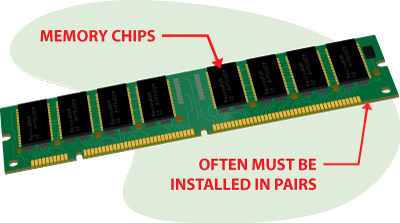| Biz ancak bu sayfa şu anda Google Translate kullanarak çevrilen makine, mümkün olduğunca çok dilde web sitemizi lokalize için çaba. | yakın |
-
-
ürünler
-
kaynaklar
-
destek
-
şirket
-
PC’niz için RAM Nasıl Satın AlınırHow to Buy RAM for your PC
Tarafından Steve Horton Şubat 07, 20117, memory, ram, SIMM, virtual memory, vista, windows, xp1 Yorum PC’nizle ilgili bir dizi makaleye ve neden istediğiniz kadar hızlı çalışmamasına hoş geldiniz. En yeni PC, özellikle Dell veya HP gibi bir all-in-one modeli bile, şişenin dar boyunu için adlandırılan darboğazlar olarak adlandırılabilir. Bilgisayarınızın bu önemli alanları, performans sorunlarına neden olan en hassas olanlardır ve bunların farkında olmanız gerektiğini ve PC’nizi yavaşlatmasını nasıl önleyeceğinizi düşünüyoruz. Bu makaleler, yeni bir bilgisayar satın aldığınızda ve zaten sahip olduğunuz bir ürünü optimize ettiğinizde size yardımcı olacaktır.Bugünün Sorusu: PC’niz için Ram Nasıl Alınır?
PC’nizle ilgili bir dizi makaleye ve neden istediğiniz kadar hızlı çalışmamasına hoş geldiniz. En yeni PC, özellikle Dell veya HP gibi bir all-in-one modeli bile, şişenin dar boyunu için adlandırılan darboğazlar olarak adlandırılabilir. Bilgisayarınızın bu önemli alanları, performans sorunlarına neden olan en hassas olanlardır ve bunların farkında olmanız gerektiğini ve PC’nizi yavaşlatmasını nasıl önleyeceğinizi düşünüyoruz. Bu makaleler, yeni bir bilgisayar satın aldığınızda ve zaten sahip olduğunuz bir ürünü optimize ettiğinizde size yardımcı olacaktır.Bugünün Sorusu: PC’niz için Ram Nasıl Alınır?
RAM, 32 bit Windows ve 64 bit WindowsŞu anda, hem yığın depolama (sabit diskler) hem de RAM (bellek) tarihsel olarak düşük fiyatlarda satıyorlar. Yeni PC’nizin ne kadar RAM’e sahip olması gerektiğine veya bunu yapmak için ne kadar çaba harcayacağınıza karar verirken, kolay cevap “işleyebileceği kadar”, bir bütün olarak harcamayacağınız için Bu günlerde RAM miktarını ikiye katlamak veya hatta üç katına çıkarmak için çok daha fazla. Ama bu kolay cevap ve en eksiksiz olanı değil.
RAM nedir?
RAM, PC’nizdeki bellek için başka bir isimdir. Yeni bir PC satın aldığınızda ve 2 GB veya 4 GB RAM ile geldiğinde, bu, sisteminizin veriyi içeri ve dışarı taşıdığı bellek anlamına gelir. Daha fazlası iyidir. RAM genellikle PC’nizdeki depolama ile karıştırılır, sabit diskiniz tarafından temsil edilen ve dosyaların kalıcı olarak saklandığı daha büyük bir miktar (500 GB gibi).
RAM Limitine Ulaşmak
PC’nizde çok az RAM’ınız olduğunda ve dolduğunda, sisteminiz bellek olarak daha yavaş sabit diskinizde, sanal bellek denen bir süreçte alan kullanmaya başlayacaktır. Bunun çok fazla olması bilgisayarınızı yavaşlatır, bu yüzden Windows’un pek çok RAM’e sahip olmak zorunda kalmasını istemediğinizden emin olmak istersiniz.Eski Sistem Sınırlamaları
Dell, Gateway ve HP gibi firmalardan özellikle birkaç yıllık, özellikle hepsi bir arada sistem, maksimum RAM miktarının ne kadar sıklıkta yapılacağı konusunda ciddi bir şekilde sınırlıdır. Sisteminiz yalnızca 2 GB ile çalışabilir. Windows 7 ve birkaç uygulama çalıştırmak için yeterlidir. (Windows XP’nin daha küçük bir bellek alanı vardır ve RAM sınırlamaları olan sistemler için çok daha akıllıca bir seçimdir.) Ayrıca, dizüstü bilgisayar veya dizüstü bilgisayarlar, özellikle de netbook’lar, RAM’i yükseltme becerilerinde sıklıkla sınırlıdır. Hatta bazıları, RAM’i yükseltmek için imkansız olmasa bile zorlaştırmak için gidebilir. Birkaç ay öncesine kadar beş yaşında bir Dell dizüstü bilgisayarım vardı. Alttaki bir panelden RAM modüllerinden birine (SIMM olarak adlandırılır) kolayca erişebilmenize rağmen, diğer SIMM, o yuvadaki RAM miktarını yükseltmek için klavyeyi çıkarmak için bana göz açmamı istedi. En az kullanıcı dostu değil!Ne tür bir RAM?
PC’nizle ilgili en ezoterik şeylerden biri, sahip olması gereken bir çeşit RAM türü. Bir bilgisayarın yüklü olduğu RAM miktarını ifade etmek yaygın olsa da, orada gerçekten hiçbir gerçek standart yoktur.Orada bellek modülü türleri ve hızları yayınlanan onlarca düzinelerce var, bu yüzden RAM’inizi yükseltme, göründüğü kadar kolay değil – – Doğru hızı ve RAM türünü satın almanız gerekiyor. Ek olarak, bazen RAM modülleri çift olarak kurulmalıdır. Ne kadar RAM yuvasına sahip olduğunuzu ve hangi RAM türünü bulduğunuzu bulmanıza yardımcı olmak için veri tabanına ve / veya crucial.com adresindeki ücretsiz tarama aracına göz atın . Ne kadar slotun dolduğunu, ne tür bir RAM’in ihtiyacınız olduğunu ve benzerlerini öğrendikten sonra, doğru modülleri satın almak kolaydır. Ancak bunları yüklemek için yardıma ihtiyacınız olabilir. Kullanıcı el kitabınız genellikle bir RAM kurulum kılavuzu içerecektir veya size yardımcı olacak bir bilgisayar bilgisine sahip olacaktır. Bir masaüstü PC durumunda, bir tornavida içerir, kasanızı açar ve SIMM yuvalarınıza ulaşmak için bazı şeyleri yoldan çıkarırsınız. Aslında modüllerin dışarı çıkması ve / veya yerleştirilmesi bir parça kekdir.Yüklediğiniz ve yeniden başlattığınız RAM miktarını yükselttikten sonra, bilgisayarınız herhangi bir zamanda daha fazla bilgiyi işleyebildiğinden, PC’nizin performansında (ne kadar eklediğinize bağlı olarak) önemli bir artış olduğunu fark etmelisiniz.
32-Bit vs 64-Bit Windows Faktörü
Ne yazık ki, 32-bit Windows işletim sistemlerinin ciddi bir sınırlaması yok. Sisteminizin gerçekte ne kadar RAM’e sahip olduğuna bakılmaksızın, sadece 3,5 GB RAM’e kadar yararlanabilirler. Gerisi uykuda. Bu yazıyı yazdığım Toshiba dizüstü bilgisayar gibi gittikçe daha fazla sayıda PC, 64 bit Vista veya XP gibi, yüklü olan tüm RAM’ları kullanabilen 64 bit Windows 7 ile önceden yüklenmiştir. PC’nizde (Windows 7, 128 GB RAM’e kadar destekleyebilir!). Bu, modern oyunlar oynarken, Photoshop kullanarak, 3D grafikler veya diğer donanım yoğun aktiviteler oluştururken büyük bir fark yaratıyor. Bu durumlarda, 64-bit işletim sistemine ve PC’nin kullanabileceği kadar RAM’e sahip olmak bir zorunluluktur. Bu durumlarda, uygulamanın kendisinin (Photoshop gibi) 64 bit yerel olduğu da yardımcı olur. Bunu uygulamanın hangi dizine yüklendiğini söyleyebilirsiniz. Program Files’a inerse, 64 bitlik bir uygulamadır; Program Files’a (x86) inerse, bu 32 bitlik bir uygulamadır.Bazen, bir uygulamanın 64 bit sürümünü bulmak sinir bozucu olabilir. Örneğin, yakın zamana kadar, 64 bitlik bir bilgisayardaysanız ve iTunes’u indirmişseniz, indirme işlemini tamamlayana ve uygulamayı yüklemeye başladığınıza kadar, uygulamanın 64 bit sürümünü indirmeniz gerektiğini söylemişti. 64 bit bilgisayarlar daha yaygın hale geldikçe, yazılım üreticileri Windows’un hem 32 hem de 64 bit sürümünü destekleyen uygulamalar yaratıyor.
İşletim sisteminizin bit hızını bilmiyorsanız, Windows Vista ve 7 size kolayca anlatabilir. Başlat menüsüne tıklayın -> Denetim Masası -> Sistem. Yanıt için Sistem Türü’ne bakın. Windows XP’de, biraz daha kıvrımlı: Başlat’ı ve ardından Çalıştır’ı tıklayın. Sysdm.cpl yazın ve Tamam’ı tıklatın, ardından Genel sekmesini tıklatın. Sistem altında, 32 bit veya 64 bit Windows olup olmadığını size söyler. XP çağında, 32 bit şimdiye kadar çok daha yaygındı, yani, eğer XP’niz varsa 32 bit var.
Alt çizgi
RAM ucuz ve bilgisayar hızında büyük bir fark yaratıyor! PC’niz çok fazla işleyebildiği sürece, 32 bit işletim sisteminiz varsa, 3 veya 4 GB RAM’e kadar yükseltme yapmaktan çekinmeyin. Sisteminizin tüm yönleriyle muazzam bir hız farkı göreceksiniz. Hafızanın şu anki kadar ucuz olması, bunu yapmamanın bir sebebi yok. Sisteminiz kullanamayacağından ve paranızı boşa harcayacağınızdan, 64 bit işletim sisteminiz yoksa 4 GB’nin üzerine çıkmayın. Ve her zaman sisteminizin kullanabileceği en iyi RAM’i elde edin ve eğer varsa RAM’leri çiftler halinde satın alın; Aynı tip ve hızdaki her bir modül çiftinden daha iyi performans elde edersiniz.Was this post helpful?YesNoÜcretsiz Sürücü Güncellemeleri
Daha iyi keyif almak için sürücülerinizi 2 dakikadan kısa sürede güncelleyin bilgisayar performansı - Ücretsiz.
Ücretsiz Sürücü Güncellemeleri
Daha iyi keyif almak için sürücülerinizi 2 dakikadan kısa sürede güncelleyin
bilgisayar performansı - Ücretsiz.
Cevap bulamadınız mı?Dünyanın dört bir yanından uzmanların eden bir soru sormak ve hiçbir zaman bir cevap alırsınız.most relevant yeni makaleler Pinterest'te Sabitle
